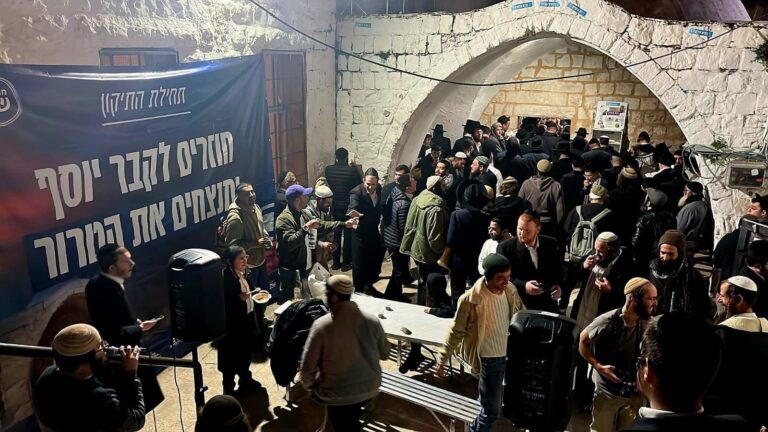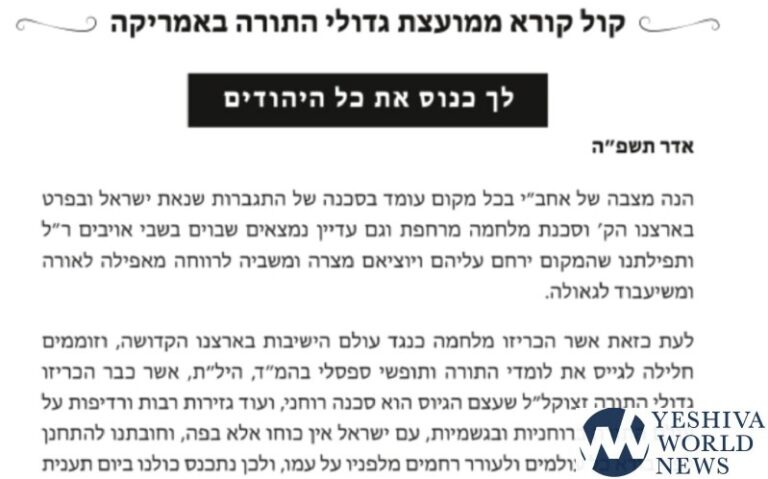By Rabbi Yair Hoffman for the Five Towns Jewish Times
They came on Shabbos. There were three of them. Young men between 17 and twenty. They came from a boys’ camp situated not too far from a girls’ camp. And, yes, they came to visit their, um, sisters.
The Rav of the camp was called to speak to them about an entirely unrelated issue. He lovingly explained to them that they had violated something called “T’chum Shabbos.” He also explained to them that, halachically, the were not allowed to venture beyond a seven foot radius. The young men scrupulously observed what the camp Rav had told them until the end of Shabbos.
What this story points out, among other things, is the unfortunate ignorance of the halachos called Tchum Shabbos.
This is an issue of particular importance during the summer months, when huge numbers of Jewish families go up to the Catskills. The truth is that anyone that goes up to the mountains and is there for a Shabbos should attend a shiur that deals with the halachos of T’chum Shabbos. What follows is a brief overview, and some of the pertinent halachos.
Please keep in mind that one should always ask a competent Rav or Posaik about any of these issues when it comes to halacha l’maaseh. The vast majority of people are entirely unfamiliar with this important area of halacha.
HALACHIC DEFINITIONS
TECHUM
The term “Techum” means the border or boundary – the limit in which one may walk on Shabbos. In a vacuum, where there are no other homes that could constitute a “halachic city” – you may only walk up to 2000 amos past your residency.
SHEVISA
“Shevisa” means where you have established your residency for Shabbos – or your “home base.” A person may walk 2000 Amos in any direction of his or her established Shevisa – home base. The Shevisa, however, can be expanded beyond just a home – it can be expanded to a halachic city.
A HALACHIC CITY
When there are six or more inhabitable homes next to each other but not more than 70 amos from one another, this is considered a halachic city. The halachic city can now be one’s residency – any area of that halachic city. But what does that mean exactly?
THE BOX
A box is created out of the houses where the most northerly house is the northern border, the most easterly house is the eastern border, the most westerly house is the western border, and the most southerly house in the southern border. If the house has a fence that is more than 10 tefachim high, then that fence can be counted as the house as well – to be within the 70 amos. Others say that the box does not just follow the directions of the world, but must be made in the shortest possible distance.
A city can extend – as long as there are houses within 70 amos. If there are two groups of six houses then you can actually have 140 amos in between the houses.
It is universally recognized that the definition of a halachic city has nothing to do with the legal municipalities.
TECHUM SHABBOS IN TERMS OF MILES
What is Techum Shabbos in terms of miles? How much is 2000 Amos? An Amah is 21.25 inches according to Rav Moshe Feinstein zt”l. The Chazon Ish holds it is about ten percent more and Rav Chaim No’eh holds that it is about ten percent less. Thus, the 2000 amos are anywhere between 1/2 a mile to 2/3rds of a mile according to Rav Moshe. Of course everyone should consult a competent Posaik for specific guidelines in his or her community.
EXTENDED BOUNDARIES AND THEIR LIMITS
You may walk 2000 amos past your box. (In addition to that, according to the Tur and Ramah, you have another 70 amos before the 2000 amos – called a Karfah. The Mishna Brurah 398:5 writes that one should not protest if one is lenient with the Tur.)
If, however, your 2000 amos takes you into the next city but that next city was not within 140 amos of your city – then you must stop at that 2070 amos invisible border.
RE-ESTABLISHING ONE’S SHEVISA
It is possible, however, to establish one’s place shevisa – their legal residence – elsewhere – in other words not in one’s actual house in between where one is has slept and where one wants to go. In other words, with pre-planning, you can have a different home base, one in between your home for the summer and the shul you want to visit.
How can this be done?
This can be done by placing food in a place where one wishes to establish Shevisa and reciting a special formula found in the Siddur. Thus, all one has to do is leave a jar of peanut butter that would spread over four slices of bread and the issue is addressed.
SOME SEFORIM
In recent year, there have been three Seforim that have been printed on the issues of Techum Shabbos as it applies specifically to Lakewood. No Seforim, to this author’s knowledge, have been written about the Catskills.=The first of the Lakewood Techumim Seforim is by Rabbi Chaim Tzvi Gorelick, and was republished in 5774. The second is by Rabbi Yoseph Chananya Jacobovits and was published in 5772. The third is Gvul HaYam by Rabbi Yitzchok Menachem Weiss, published in Taives of 5775.
BOXING UP DEBATES
The new seforim deal with some of the various halachic debates that can make things rather complex. For example, it is possible that when a northern area of a city is boxed out – the box could encompass parts of the southern area of the city. But there are times when the southern area is boxed out and it may not actually reach many parts of the northern area. This gives rise to the halachic debate as to whether, when the two parts are boxed out, the parts are considered one city or not.
THE TWO SIDES OF THE DEBATE
Aside from how one learns the halachic issues and the sources, the question arises as to what the leading Poskim held. How did our Gedolei HaDor pasken this essential shailah? The Gvul HaYam (pages 25-28) gives a nice summary of the various positions. Of course, his conclusions are not necessarily agreed upon by all parties concerned.
There is a debate as to what the Chazon Ish held. Rav Chaim Kanievsky Shlita, and Rav Dovid Feinstein Shlita hold that the Chazon Ish was of the opinion that a city can be combined through boxing. Rav Nissim Karelitz holds that his position that the boxing out does not make it into one city. [In the Shoneh Halachos of Rav Chaim Kanievsky, he does write that it needs further analysis.] The Chazon Ish itself has it in brackets [and the matter remains undecided].
Dayan Weiss (Minchas Yitzchok Vol. VIII #33) held that boxing out does combine cities. Rav Yaakov Kamenetsky zt”l also possibly held that boxing out combines them.
Rav Elyashiv zt”l is quoted that boxing out does not combine cities (Machane Yisroel 3:6). It is said, however, that he allowed it for students of RJJ in Edison that were in Robert Wood Johnson Hospital to walk to a minyan in Edison.
Rav Vosner zt”l is cited in the Dirshu Mishna Brurah that boxing out does combine cities.
Rav Nissim Karelitz holds that it does not.
Rav Shmuel Kamenetzky holds that boxing out does combine cities.
Rav Shlomo Miller holds that boxing out does combine cities.
Rav Yisroel Belsky zt”l held that one should not rely on boxing out to combine a city.
The Sefer Birurei HaMidos (a student of the Nodah BiYehudah) states, “veharibuyah aino michlal ha’ir and the box is NOT WITHIN THE CONFINES OF THE CITY.”
Of course, these are conclusions of the Gvul HaYam and are not necessarily fully agreed to by others who have interacted with these Poskim.
OTHER ISSUES
There is another question that is also debated. Even after one boxes out a city can a new box be made? Rav Shlomo Miller shlita is of the opinion that one cannot make a newer and bigger box. (The third sefer references his view.)
A CITY BOW
There is also the question of what the status is of a city within a keshes – a city bow. There is a halacha that if there is a city in the shape of a bow where either there is less than 4000 amos from the two ends of the city, and/or it is within 2000 amos of the out perimeter of the bow – then the entire bow is considered part of the city. What if the boxed out city lay within the city bow – will this connect the city in a manner that is halachically more acceptable than a boxed out city? This too may be a leniency – even according to those who do not hold that boxing out a city connects it to another halachic city.
THREE KEFARIM [TOWNS]
There may be a third issue too. The Gemorah in Eiruvin 57b states that if there are three cities in the shape of a triangle, one may “virtually” move the upper city to lay in between the two cities to form a straight line allowing for the techum to be extended past the tchums of the other two cities. The limitation is that it cannot moved even virtually past 2000 amos. But does this make it one city as well, or does it just allow one to walk 2000 amos from one side to the other? Also can the city be “virtually moved” if the space that it is moved into is not as wide as that city? This issue is left out of Shulchan Aruch. Some are of the opinion that because of this – it is a problem. Others feel that it is not a problem at all.
RAMPANT IGNORANCE
The issues of Techum Shabbosapply to virtually every city in America and Israel with a frum population and are particularly applicable to bungalow colonies.
The sad truth is that most people ignore all issues having to do with Techum. The halachos of Techum Shabbos have become the step-child of Torah learning – “Oh, yes, we always skip that part.”
Torah should have no step-children.
Each summer camp, each bungalow colony, and each Sumer community should try to arrange for shiurim in this critical area of Shabbos observance.
Rav Shlomo Alkabetz, the author of the lecha dodi writes that Shabbos observance is the source of blessing for the Jewish people. This is the meaning of what we say in the lecha dodi – ki hi mekor habracha.
Let us try to bring blessing to our communities.
The author can be reached at [email protected]












2 Responses
I find it hilarious that the camp Rabbi had to corral the boys into a circle. Techum notwithstanding, it’s really funny, they were surely there to visit their “uh, sisters”.
Very interesting article. How did these “brothers” think it is OK to venture into a girls’ camp in the first place? The Rav was certainly creative!